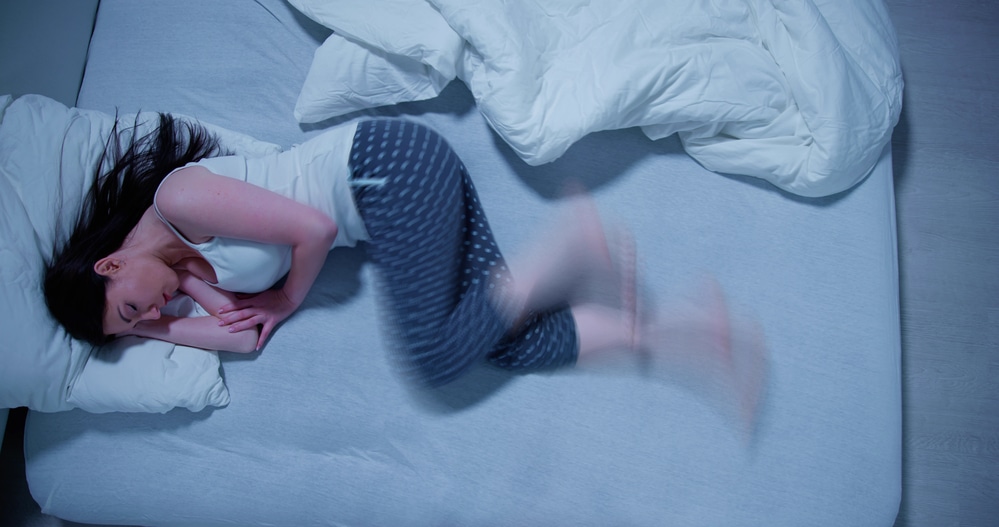Restless Leg Syndrome (RLS), also known as Willis-Ekbom Disease, is a neurological disorder characterized by an overwhelming urge to move the legs. This condition often occurs during periods of rest or inactivity, such as when sitting or lying down. Individuals with RLS may experience uncomfortable sensations in their legs, described as crawling, tingling, itching, or pulling. These sensations are temporarily relieved by movement but can significantly disrupt sleep and daily activities.
Understanding RLS requires an examination of its symptoms, causes, diagnosis, and management strategies. While the exact cause of RLS remains unknown, research suggests that genetic factors and certain underlying medical conditions may contribute to its development. Diagnosis typically involves a thorough medical evaluation and assessment of symptom severity using standardized questionnaires. Treatment options for RLS include lifestyle changes such as regular exercise and avoiding triggers like caffeine or nicotine, as well as medications that help to alleviate symptoms. Additionally, alternative therapies and coping strategies can provide additional support for individuals living with this chronic condition. As future research continues to shed light on the mechanisms behind RLS and advances in treatment options emerge, it is crucial to maintain a comprehensive understanding of this syndrome’s impact on individuals’ lives and explore effective management techniques that enhance their quality of life.
Understanding Restless Leg Syndrome
Restless Leg Syndrome (RLS) is a neurological disorder characterized by an uncontrollable urge to move the legs, typically accompanied by uncomfortable sensations. This condition affects both the voluntary and involuntary movements of the legs, leading to restlessness during periods of inactivity or sleep. The exact cause of RLS is still unknown; however, research suggests that it may be linked to abnormalities in the dopamine system in the brain.
Understanding RLS is crucial for effective management and treatment. People with RLS often experience unpleasant sensations in their legs, such as itching, tingling, or a crawling sensation. These sensations can range from mild discomfort to severe pain and can significantly disrupt sleep patterns. As a result, individuals with RLS often struggle with insomnia and chronic fatigue.
Treatment options for RLS aim to alleviate symptoms and improve quality of life. Non-pharmacological approaches include lifestyle modifications such as regular exercise, avoiding triggers like caffeine or alcohol, and maintaining a consistent sleep schedule. Additionally, techniques like massage or hot/cold therapy may provide temporary relief from discomfort.
In more severe cases where non-pharmacological methods are insufficient, medications may be prescribed. Dopamine agonists are commonly used as they help regulate dopamine levels in the brain and reduce symptoms associated with RLS. However, these medications come with potential side effects that need to be carefully monitored.
Understanding Restless Leg Syndrome (RLS) is essential for effective management and treatment of this neurological disorder. It involves an uncontrollable urge to move the legs accompanied by uncomfortable sensations that can disrupt sleep patterns and lead to chronic fatigue. Treatment options range from non-pharmacological approaches like lifestyle modifications to pharmacological interventions involving medication usage under close monitoring by healthcare professionals. Further research is needed to better understand the underlying causes of RLS and develop targeted therapies for this condition.
Recognizing the Symptoms of RLS
One key aspect to understanding restless leg syndrome (RLS) is the ability to identify and acknowledge its characteristic symptoms. RLS is characterized by an irresistible urge to move the legs, usually accompanied by uncomfortable sensations such as crawling, tingling, or burning in the legs. These sensations typically occur when a person with RLS is at rest or trying to sleep, leading to difficulty falling asleep or staying asleep. The symptoms of RLS are often worse in the evenings or at night, which can significantly disrupt a person’s sleep patterns and overall quality of life.
Recognizing RLS symptoms is crucial for accurate diagnosis and appropriate treatment. In addition to the strong urge to move the legs and uncomfortable sensations, other common symptoms of RLS may include involuntary leg movements during sleep called periodic limb movements of sleep (PLMS), worsening of symptoms with prolonged sitting or lying down, temporary relief from movement or activity, and a worsening of symptoms during periods of stress or anxiety. It is important for individuals who suspect they may have RLS to consult with a healthcare professional for an accurate diagnosis and appropriate treatment options.
Treatment options for RLS aim to alleviate symptoms and improve sleep quality. Non-pharmacological approaches may include lifestyle changes such as regular exercise, avoiding caffeine and alcohol before bedtime, establishing a relaxing bedtime routine, and practicing good sleep hygiene. Pharmacological treatments may involve medications that increase dopamine levels in the brain or medications that affect calcium channels in nerve cells. Treatment plans are individualized based on the severity of symptoms and personal preferences.
Recognizing the characteristic symptoms of restless leg syndrome is essential for proper diagnosis and management. The identification of these symptoms allows healthcare professionals to develop personalized treatment plans tailored to each individual’s needs. By addressing both non-pharmacological approaches and pharmacological interventions, individuals with RLS can experience relief from their symptoms and improve their overall quality of life.
Causes and Risk Factors of Restless Leg Syndrome

The etiology of this neurologic disorder involves a complex interplay of genetic, environmental, and physiological factors. Restless leg syndrome (RLS) is believed to have a strong genetic component, as it tends to run in families. Studies have identified several gene variants that are associated with increased risk of developing RLS. These genes are involved in the regulation of iron metabolism, dopamine neurotransmission, and the function of certain ion channels in the brain.
In addition to genetic factors, certain environmental and physiological factors can contribute to the development of RLS. Iron deficiency is one such factor that has been strongly linked to RLS. Iron plays a crucial role in the production and utilization of dopamine, a neurotransmitter that is involved in movement control. When iron levels are low, dopamine function may be impaired, leading to symptoms of RLS. Other medical conditions such as kidney disease, diabetes, and peripheral neuropathy have also been associated with an increased risk of developing RLS. Furthermore, certain medications like antihistamines and antidepressants can worsen or trigger RLS symptoms. Overall, understanding the causes and risk factors for RLS is important for both diagnosis and treatment strategies for this condition.
Diagnosis and Medical Evaluation
Diagnosis and medical evaluation of restless leg syndrome (RLS) involve a comprehensive assessment of genetic, environmental, and physiological factors to determine the underlying causes and risk factors. The diagnostic criteria for RLS include an urge to move the legs, usually accompanied by uncomfortable sensations in the legs that are relieved by movement, and worsen during periods of rest or inactivity. Additionally, these symptoms must occur primarily in the evening or at night. To confirm the diagnosis, healthcare professionals may also consider conducting a physical examination, reviewing medical history, and performing blood tests to rule out other conditions that may mimic RLS.
Once diagnosed with RLS, individuals have several treatment options available. Non-pharmacological interventions such as lifestyle modifications can be effective for managing mild cases of RLS. These may include regular exercise, avoiding triggers like caffeine and alcohol before bedtime, adopting good sleep hygiene practices, and using relaxation techniques. Pharmacological treatments can also be prescribed depending on the severity of symptoms and their impact on daily life functioning. Dopamine agonists are commonly used as first-line medications for RLS due to their ability to reduce symptoms by increasing dopamine levels in the brain. Other medications such as opioids, anticonvulsants, or benzodiazepines may be considered if dopamine agonists are not well-tolerated or ineffective. It is important for individuals with RLS to work closely with healthcare professionals to find an appropriate treatment plan tailored to their specific needs while considering potential side effects and long-term management strategies.
Lifestyle Changes to Manage RLS
Lifestyle modifications can play a crucial role in managing the symptoms of RLS. One important aspect is establishing a proper sleep position. It is recommended for individuals with RLS to avoid sleeping on their stomachs as this can exacerbate symptoms. Instead, sleeping on the back or side may help alleviate discomfort and reduce the frequency of leg movements during sleep.
Regular exercise is another lifestyle change that can significantly benefit individuals with RLS. Engaging in physical activity, such as walking, swimming, or cycling, has been shown to improve sleep quality and reduce symptom severity. Exercise not only helps regulate dopamine levels in the brain but also promotes better circulation and relieves muscle tension. However, it is important to note that excessive or vigorous exercise close to bedtime should be avoided as it may have a stimulating effect on the nervous system.
In addition to sleep position and exercise routine adjustments, avoiding stimulants before bedtime can also contribute to better management of RLS symptoms. Stimulants like caffeine and nicotine should be limited or avoided altogether in order to prevent worsening of restless leg sensations. Furthermore, adhering to good sleep hygiene practices is essential for individuals with RLS. This includes maintaining a regular sleep schedule, creating a comfortable sleep environment free from distractions, and establishing pre-sleep rituals that promote relaxation, such as taking a warm bath or practicing mindfulness techniques.
Overall, making these lifestyle changes can be beneficial for individuals suffering from restless leg syndrome (RLS). Adjusting sleep positions by avoiding stomach sleeping and adopting positions like sleeping on the back or side can help alleviate discomfort during sleep. Regular exercise not only regulates dopamine levels but also improves circulation and reduces muscle tension associated with RLS. Avoidance of stimulants before bedtime and adherence to good sleep hygiene practices further contribute towards effectively managing RLS symptoms. By incorporating these lifestyle modifications into daily routines, individuals with RLS can experience improved symptom control and enhance their overall quality of life , leading to better sleep and reduced discomfort during the night. Additionally, implementing relaxation techniques, such as mindfulness or deep breathing exercises, can help to calm the body and mind, promoting a more restful sleep. It is important for individuals with RLS to work closely with their healthcare provider to develop a personalized treatment plan that incorporates both lifestyle modifications and medication, if necessary, to effectively manage their symptoms and improve their overall well-being.
Medications for Restless Leg Syndrome
Lifestyle changes can be beneficial in managing restless leg syndrome (RLS), but in some cases, medication may be necessary to alleviate symptoms. Medications are often prescribed when non-pharmacological treatments such as regular exercise, avoiding caffeine and alcohol, and improving sleep hygiene do not provide sufficient relief. It is important to note that medications should always be prescribed by a healthcare professional who specializes in treating RLS.
There are several types of medications that may be used to treat RLS. Dopaminergic agents, such as pramipexole and ropinirole, work by increasing dopamine levels in the brain, which helps reduce the symptoms of RLS. These medications have been shown to effectively improve sleep quality and reduce the frequency of leg movements associated with RLS. However, they can sometimes cause side effects such as nausea, dizziness, or daytime sleepiness.
Another class of medications commonly used for RLS is opioids. These include drugs like codeine and oxycodone. Opioids work by binding to opioid receptors in the brain and spinal cord, reducing pain signals and providing relief from RLS symptoms. However, due to their potential for dependence and addiction, opioids are usually reserved for severe cases of RLS that do not respond well to other treatments.
Other medications that may be used include anticonvulsants like gabapentin or pregabalin, which help reduce nerve-related discomfort associated with RLS; benzodiazepines like clonazepam which promote relaxation and improve sleep quality; or iron supplements if deficiency has been identified as a contributing factor.
It is important to discuss the potential benefits and risks of different medications with your healthcare provider before starting any treatment regimen. They will consider factors such as your overall health profile and any existing medical conditions you may have when determining the most suitable medication for your specific case of restless leg syndrome.
Alternative Therapies and Natural Remedies
Alternative therapies and natural remedies are often sought after by individuals looking to manage their symptoms of RLS in a non-pharmacological manner. Herbal remedies have gained popularity among those seeking alternative treatments for restless leg syndrome. Some herbal supplements, such as valerian root and chamomile, are believed to promote relaxation and improve sleep quality, which can help alleviate RLS symptoms. However, it is important to note that the effectiveness of these herbal remedies in treating RLS has not been widely studied or scientifically proven. Therefore, individuals considering the use of herbal remedies should consult with a healthcare professional before incorporating them into their treatment plan.
Another alternative therapy that some individuals with restless leg syndrome may consider is acupuncture. Acupuncture is an ancient Chinese practice that involves inserting thin needles into specific points on the body to stimulate energy flow and restore balance. Proponents of acupuncture argue that it can help relieve pain and improve overall well-being by activating the body’s natural healing processes. While there is limited scientific evidence specifically evaluating the efficacy of acupuncture for treating RLS, some studies have suggested that it may provide temporary relief from symptoms. However, more research is needed to fully understand its potential benefits for individuals with restless leg syndrome.
Alternative therapies and natural remedies such as herbal supplements and acupuncture are often explored as potential options for managing symptoms of restless leg syndrome without relying solely on medications. While some individuals may find these approaches helpful in alleviating their symptoms, it is essential to approach them with caution and consult with a healthcare professional before initiating any new treatments. Further research is necessary to determine the true efficacy of these alternative therapies in effectively managing restless leg syndrome.
Coping Strategies for Daily Life with RLS

To effectively manage the daily challenges associated with restless leg syndrome, individuals may employ various coping strategies in their everyday lives. One of the primary coping strategies for individuals with RLS is establishing a consistent sleep routine. This involves going to bed and waking up at the same time every day, even on weekends, to regulate their sleep-wake cycle. Creating a relaxing bedtime routine can also help alleviate symptoms and promote better sleep. This may include activities such as taking a warm bath, practicing relaxation techniques like deep breathing or meditation, and avoiding stimulating activities before bed.
Another coping strategy for individuals with RLS is engaging in regular exercise. Physical activity has been shown to reduce symptoms of RLS and improve overall sleep quality. Engaging in moderate-intensity aerobic exercises such as walking or swimming for at least 30 minutes most days of the week can be beneficial. However, it is important to avoid vigorous exercise close to bedtime as it may increase symptoms temporarily.
In addition to these strategies, managing stress levels through stress-reduction techniques like yoga or mindfulness meditation can also be helpful for individuals with RLS. Stress has been found to exacerbate symptoms of RLS, so finding healthy ways to cope with stress can have a positive impact on symptom management.
Overall, implementing coping strategies such as maintaining a consistent sleep routine, engaging in regular exercise, and managing stress levels can greatly improve daily life for individuals living with restless leg syndrome. By incorporating these strategies into their everyday routines, individuals can minimize sleep disturbances and effectively manage their symptoms.
RLS in Children and Adolescents
RLS, or restless leg syndrome, is a neurological disorder characterized by an irresistible urge to move the legs, often accompanied by uncomfortable sensations. In our previous subtopic, we discussed coping strategies for individuals living with RLS in their daily lives. Now, we shift our focus towards RLS in children and adolescents.
Restless leg syndrome is not limited to adults; it can affect children and adolescents as well. However, the prevalence of RLS in this age group is relatively lower compared to adults. Studies have estimated that around 2-4% of children and adolescents experience symptoms of RLS. These symptoms may manifest differently in younger individuals compared to adults, making diagnosis challenging at times.
The impact of RLS on children and adolescents can be significant. The discomfort caused by the condition can disrupt sleep patterns, leading to daytime fatigue and impaired concentration in school. Furthermore, the urge to move their legs during periods of rest or relaxation can interfere with social activities and hobbies that require sitting still for extended periods. This disruption may result in emotional distress and frustration among young individuals who are unable to fully participate in activities they enjoy.
While less prevalent than in adults, restless leg syndrome does affect a notable number of children and adolescents. The impact it has on their daily lives can include disrupted sleep patterns and limitations on social activities due to the need for movement. It is essential for healthcare professionals to consider this condition when evaluating symptoms presented by younger individuals so that appropriate management strategies can be implemented.
Future Research and Advances in RLS Treatment
Advances in research on the treatment of restless leg syndrome have the potential to improve the quality of life for individuals affected by this neurological disorder. One area that holds promise is the application of advances in technology. For instance, wearable devices and smartphone applications can track movement patterns and provide real-time feedback to patients, helping them identify triggers for their symptoms and manage their condition more effectively. Additionally, emerging technologies such as neurostimulation devices show potential in alleviating RLS symptoms by targeting specific areas of the brain or spinal cord involved in motor control.
Another avenue for future research lies in gene therapy. By understanding the genetic basis of restless leg syndrome, scientists can develop targeted therapies that address the underlying causes of the disorder rather than just managing its symptoms. Gene therapy holds particular promise because it has the potential to provide long-term relief from RLS symptoms by correcting genetic abnormalities or enhancing mechanisms involved in dopamine regulation, which plays a crucial role in RLS pathophysiology.
Advances in technology offer new opportunities for monitoring and managing restless leg syndrome, while gene therapy holds promise for developing targeted treatments that address the root causes of this disorder. Continued research efforts in these areas may lead to improved outcomes and a better quality of life for individuals living with RLS.
Conclusion
In conclusion, Restless Leg Syndrome (RLS) is a neurological disorder that affects millions of people worldwide. It is characterized by an irresistible urge to move the legs, usually accompanied by uncomfortable sensations. RLS can significantly impact a person’s quality of life, leading to sleep disturbances and daytime fatigue.
Recognizing the symptoms and understanding the causes and risk factors of RLS are crucial for proper diagnosis and management. Medical evaluation and lifestyle changes, such as regular exercise and maintaining good sleep hygiene, can help alleviate symptoms. Alternative therapies and natural remedies may also provide relief for some individuals.
Coping strategies for daily life with RLS involve finding ways to manage symptoms during periods of increased discomfort or restlessness. Additionally, it is essential to address RLS in children and adolescents as they may experience similar challenges but require unique treatment approaches.
Future research holds promise for advancing our understanding of RLS and developing more effective treatments. Continued efforts in this field will contribute to improved quality of life for individuals living with RLS. Overall, managing RLS involves a multidisciplinary approach that combines medical interventions, lifestyle modifications, alternative therapies, coping strategies, and ongoing research advancements.


